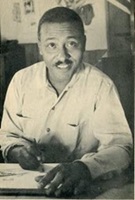
In observance of Black History Month, I pulled together a list of some notable and influential writers, poets and artists published by HMH’s predecessor companies, Harcourt, Brace & Company and Houghton Mifflin, during the Harlem Renaissance.
Harcourt, Brace & Company was founded in 1919 and immediately began publishing new styles of books filled with fresh ideas that celebrated all people. Alfred Harcourt later explained that one of the reasons he and Donald Brace founded Harcourt, Brace & Company was because at his previous employer, Holt & Company, “I saw I was not going to be able to publish books dealing with the new ideas with which the world was seething.” Among those new ideas was publishing the work of African American authors.
In the years just after World War I, poets, playwrights, novelists, and writers of all types flocked to New York City’s Harlem along with musicians, painters and other artists – a movement that would later be called The Harlem Renaissance. In his book titled, The Harlem Renaissance in Black and White, Cornell University Professor George Hutchinson discusses the state of publishing during this time, noting, “While the Bonis, Liveright and Knopf published the most famous books of the Harlem Renaissance, no firm was more closely and diversely related to the movement than Harcourt, Brace which published African American literature from its very beginning.”

Claude McKay
Claude McKay was a Jamaican-American writer and poet and a key figure in the Harlem Renaissance. He was born in Jamaica, travelled Europe, and then arrived in New York City just before World War I. His book Harlem Shadows was published by Harcourt, Brace in 1922. As you can see from the photo of the dust jacket, Harlem Shadows was book number 234 published by the firm. However, it was not the first book by an African American to be published by Harcourt, Brace.
W.E.B. DuBois
W. E. B. DuBois, whom Alfred Harcourt had published while he was at Holt & Company, moved with Harcourt to the new firm to publish his 1920 novel Darkwater: Voices from within the Veil. The book, the first one from an African American author published by Harcourt, Brace, embodies the modernist ideas of the time by combining essays, poems and spirituals into an autobiographical story of black lives.

James Wheldon Johnson
James Wheldon Johnson was a well-established poet, teacher and leader in the National Association for the Advancement of Colored People (NAACP). He was well-respected among Harlem Renaissance writers, a sort of elder statesmen for the artists of the time. Although he published his books of poetry with other publishers, he edited the 1925 anthology The Book of American Negro Poetry, which was not only a hit trade book, but also a top seller for many years for the Harcourt college department.
Weldon wrote the introduction to Sterling Brown’s 1932 poetry collection, Southern Road, where he names McKay and Brown, along with Jean Toomer, Countee Cullen and Langston Hughes, whom he called the “younger poets,” as the five best poets of the time.

Sterling Brown
Sterling Brown was the son of a school teacher and a Howard University theology professor. He went on to become a professor of literature himself, and was particularly interested in the American South and its culture, folklore and literature. He credited Robert Frost and fellow HMH poet Carl Sandburg for making him aware of “the extraordinary in ordinary life.” His poems emulate the rhythms of ballads, folksongs, jazz and blues.
Brown’s collection of poetry, Southern Road, was illustrated by another amazing Harlem Renaissance figure, E. Simms Campbell.

E. Simms Campbell
Campbell was the first African American cartoonist to be published in national magazines, and he was Esquire’s main illustrator from its first issue in 1933 until the early 1960s. His style was incredibly varied, as is evident from his Southern Road illustrations (left) compared to the work that he did for Esquire and The New Yorker.
 |
 |
 |
 |
In addition to his cartoons, Campbell also illustrated many advertisements. At the time, it was unusual to hire an African American artist to illustrate mostly white characters, and both Campbell and his publishers – while not exactly hiding it – kept his race something of a secret to avoid problems when distributing his work. While that approach ensured him great commissions and a wide readership, it may also be why he isn’t very well known today.

Arna Bontemps
Finally, Campbell also illustrated the children’s book, Popo and Fifina, which was the first collaboration between Langston Hughes and Arna Bontemps. Bontemps was a poet, novelist, children’s book writer and essayist, and was one of several authors to be published by both Harcourt, Brace and Houghton Mifflin. He wrote 25 books and contributed to ten others about African Americans and the African American experience. In his 1945 Houghton Mifflin book, We Have Tomorrow, he arranged a collection of 12 biographies of African American pioneers in different fields. One of them was E. Simms Campbell.

















